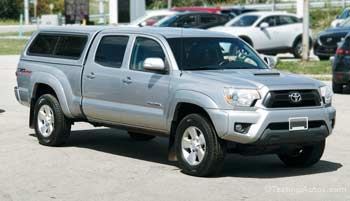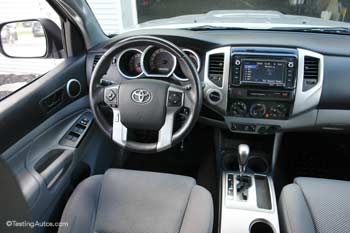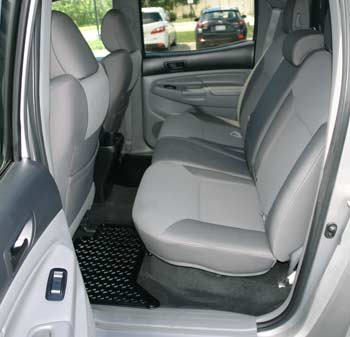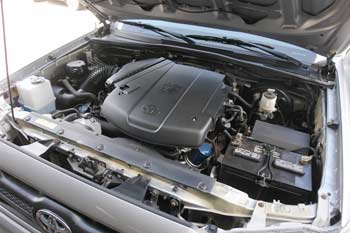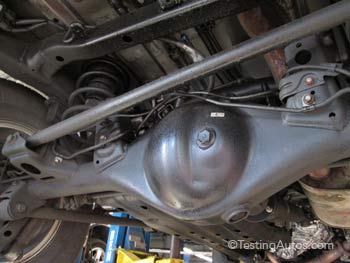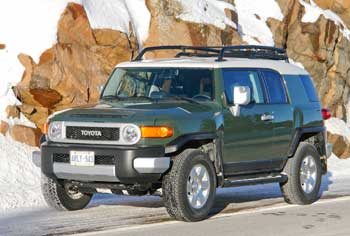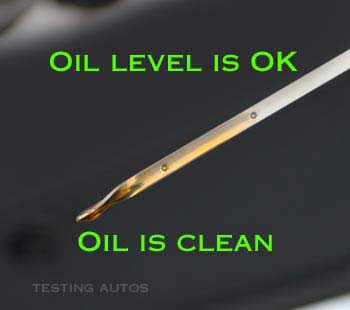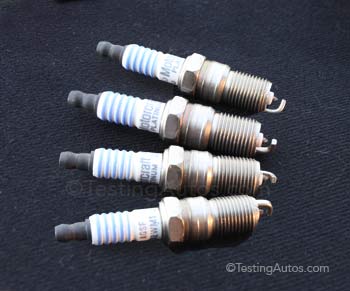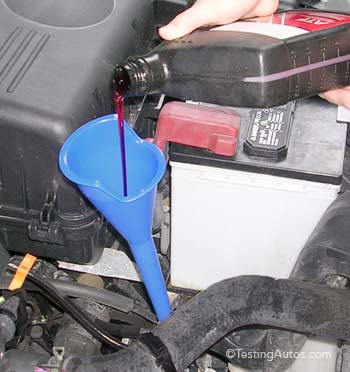Toyota Tacoma 2005-2015: common problems, engines, 4WD care
Updated: January 21, 2023
The 2005-2015 Toyota Tacoma is a simple, practical mid-size truck with a 5- or 6-foot rugged composite bed. It offers a solid 2.7L 4-cylinder or a strong 4.0L V6 with either a manual or automatic transmission. Both motors are available in 4x2 or 4x4 configurations.The Tacoma comes as a regular cab, Access Cab extended cab or Double Cab crew cab (in the photo). Double Cab is available with a 5 or 6-foot bed; all other trims have a 6-foot bed.
The 4x2 Toyota Tacoma with a 4-cylinder engine is one of the most fuel-efficient pickup trucks with an EPA rating of 20/25 mpg city/highway (2011-2015 Tacoma with a manual transmission).
The 2012-2015 4x4 V6 auto Tacoma gets 16/21 mpg. Maximum towing capacity for different V6 trims with Tow Package is listed between 6,300 and 6,500 lbs.
The 4x4 Tacoma has a simple part-time 4WD system (2H 4H 4L) with an electronically controlled 2-speed transfer case. A locking rear differential is available as an option.
In a part-time 4WD system, the transfer case rigidly locks the front and rear axles, meaning it should not be used on dry pavement.
The Tacoma's interior is not as roomy as in larger trucks, but durable and functional. The powertrain is reliable and easy to work on. The Tacoma will hold its value well if you keep it in good shape. Of course, the question is what are the common problems?
Toyota Tacoma reported problems:
A/C not working: There are several reasons why the A/C might stop working. It could be because of a leak (e.g., in the A/C condenser) or because of a problem with the A/C compressor. Your mechanic will have to test the system for leaks first.One area that is often mentioned is the blower motor and blower motor resistor. If the blower motor resistor fails, it could cause the blower motor to work only at the highest speed. Watch these Youtube videos covering the blower motor resistor.
The blower motor itself can fail and stop working completely. Mechanics check power and ground at the blower motor connector and if OK, the motor is bad. Another way to check is to measure the blower motor's resistance. If there is no continuity, the motor is bad. Luckily, it's not very difficult to replace.
Wheel bearing noise: Front wheel bearings are common to fail and cause a humming or rumbling noise. Replacing one wheel bearing (front or rear) in a 4WD model will cost about 2.7 hours of labor plus the cost of the part. The dust shield may need to be replaced too if rusted.
Overhead compass/temperature display: it may stop working. Replacing the unit is not too difficult, but the part costs over $100. However, there are many YouTube videos showing the repair.
Jolt when coming to a stop: It's another common problem familiar to many truck owners. It's like someone bumps the truck slightly from behind. This problem might be caused by a lack of lubrication on the slip yoke of the driveshaft. Greasing the slip yoke regularly usually takes care of this problem.
Driveshaft u-joints: They are common to go with age and cause vibration. Often it's more noticeable when accelerating. Replacing driveshaft u-joints is not too difficult. If one u-joint is bad, it may make financial sense to replace other u-joints and the support bearing at the same time if they show signs of wear.
Frame rust: Rust damage to the frame has been reported by many owners on the NHTSA website, mostly in the 2005-2008 model years. Trucks from areas with high road salt usage or high humidity are more likely to have rust damage.
Toyota replaced frames in some eligible trucks under warranty; some other trucks received corrosion resistant compound (CRC) application of the frame (Warranty Enhancement Program ZH6 and Limited Service Campaign H0F).
Campaigns were available for vehicles registered in Cold Climate States. However, we found a number of more recent complaints on the NHTSA website about rusted frames. Some owners report that the frame is rusted, but the dealer says that the warranty coverage has expired.
We also found Customer Support Program ZKA and Limited Service Campaign K0D related to the frame corrosion for the 2011-2017 Tacoma in cold climate states, but at the time we worked on this post, they were in early stages.
Considering the importance of the frame, if you are looking to buy a used Toyota Tacoma, it's good to know if the frame has been replaced or received CRC application under one of the campaigns.
Before buying the truck, it's important to have the frame carefully inspected for rust and other damage by a mechanic while the truck is on the lift. A simple visual inspection will not be enough, as rust might be hidden.
This also means that if you have a Toyota Tacoma, you might want to check with Toyota if the VIN number of your vehicle is eligible for any of the service campaigns.
It's also a good idea to have the condition of the frame checked periodically during regular services. Consider rustproofing for extra protection. YouTube has several interesting videos about frame rust.
Weak rear leaf springs: This is another common complaint. Toyota issued Safety Recall E02 for certain model year 2005-2011 Toyota Tacoma Pre-Runner and 4x4 vehicles (NHTSA Campaign Number: 14V604000) to replace rear leaf spring assemblies. Check for recalls at the NHTSA website.
Another problem is that the rear leaf springs tend to squeak when driving over bumps. Typically leaf springs squeak when leaves rub against each other, for example, when the spacers are worn out or missing.
Toyota issued T-SB-0274-09 for the 2005-2009 Tacoma that recommended installing updated leaf spring silencer pads. Read also: Squeaking leaf springs: causes, repair options If you are buying a used Toyota Tacoma, watch out for the rear end of the truck sag. When looking at the back of the truck, you may notice that one of the sides sits lower, which points to a weak spring. Read also: When do leaf springs need to be replaced?
Faulty air/fuel ratio sensor (A/F sensor): it can cause the Check Engine with the trouble code P0135 or other problems. Sensors are designated as, for example, B1S1 meaning Bank 1 Sensor 1 (upstream sensor).
The upstream sensor, or Sensor 1 is installed in the exhaust before the catalytic converter; Sensor 2 is the one after the catalytic converter. In a V6 engine there are two banks. See the diagram of the cylinder banks in the 1GR-FE engine.
B2S1 means Bank 2 Sensor 1. An aftermarket A/F sensor costs $50-$75 and is not very difficult to replace. The sensor connector must also be checked and cleaned whenever the A/F sensor is replaced.
The Toyota Service bulletin T-SB-0333-17 for the 2012 Tacoma describes a problem where the Check Engine light with codes P2440/P2442 could be caused by moisture intrusion into the air injection pump. The bulletin provides the inspection process and if the cause is confirmed, the air pump, air pump cover, air switching valve and gaskets must be replaced.
Now that the earlier models are out of warranty, Tacoma owners report replacing the headlights using cheaper aftermarket parts ($57-$120 for one headlight assembly). Replacing headlights is not very difficult; we found these videos on how to do it. If you want to get it done in a repair shop, it should cost $200-$360 labor (for two headlights) plus the cost of parts.
Besides this issue, similar to many other cars, the headlights tend to fade from the outside with age. Restoring headlights is easy and can even be done without any special tools. YouTube has many videos on this subject.
Related posts:
2007-2014 Toyota FJ Cruiser
2006-2014 Honda Ridgeline
Engines: The base engine is a 159-hp 2.7L 4-cylinder DOHC (2TR-FE). It's a simple engine with a conventional fuel injection. If you take care of it, it can last very long. Check out this video with the famous 4-cylinder Tacoma with over 1 million miles, where the first 2.7L engine lasted for over 800K miles.
The 4.0L V6 DOHC (1GR-FE) offers 236 horsepower. It's also known for its reliability.
If you want your engine to last longer, keep the engine oil clean and topped up and make sure the cooling system works properly and is not low on coolant.
Does the Toyota Tacoma have a timing belt or timing chain? Both the 2TR-FE and 1GR-FE engines in the 2005-2015 Tacoma have a timing chain. The timing chain doesn't need to be replaced unless it's stretched or there is some other issue with the chain drive components.
One of the reasons timing chains can fail prematurely is if the engine runs low on oil. Watch these videos about replacing a timing chain in the 1GR-FE engine.
Engine oil capacity: The engine oil capacity for the 2TR-FE engine in the 2005-2015 Tacoma is listed at 6.1 qt. or 5.8 liters (with the oil filter change). The oil capacity for the 1GR-FE engine in the two-wheel drive Tacoma except PreRunner is specified at 4.8 qt. (4.5 liters) with the oil filter change. For the four−wheel drive models and PreRunner it's listed at 5.5 qt. or 5.2 liters with oil filter change.
Check the owner's manual to be sure; you can download it from the Toyota owners website. At higher mileage, the engine may consume oil, which means that the oil level needs to be inspected regularly and topped up if needed.
4WD maintenance: The 4x4 Tacoma has a transfer case and front and rear differentials. All three units must be checked for leaks regularly. The oil in all three units must be checked and changed if dirty or in recommended mileage intervals. The driveshaft needs to be greased during regular services. Front CV axles and boots need to be inspected during oil changes as the boots tend to rip at higher mileage.
Rustproofing: Given the frame rust issues, rustproofing is not an expense, but an investment in your truck's longevity. There are many shops that can rustproof your truck for $89-$200.
This 8-years old Toyota FJ Cruiser in the photo has been regularly driven during winters with high road salt usage. As you can see, there is almost zero rust. It has been rustproofed using oil spray and re-sprayed every year. Read more: Should you rustproof your vehicle?
